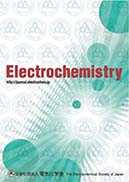
- |<
- <
- 1
- >
- >|
-
熊谷 直昭2003 年 71 巻 5 号 p. 307
発行日: 2003/05/05
公開日: 2019/08/30
ジャーナル フリーPDF形式でダウンロード (138K)
-
Yasushi UEBOU, Shigeto OKADA, Jun-ichi YAMAKI2003 年 71 巻 5 号 p. 308-312
発行日: 2003/05/05
公開日: 2019/08/30
ジャーナル フリーLithium and sodium insertions into pyrophosphates MP2O7 (M = Mo, W) were investigated electrochemically as possible cathodes for ion-transfer batteries. Lithium and sodium were reversibly incorporated in the 3D-framework of pyrophosphates MP2O7 (M = Mo, W) with liquid organic electrolytes at room temperature. The first discharge capacities were 95 mAhg−1 for A1.0MoP2O7 (A = Li, Na) and 295 mAhg−1 for A4.0WP2O7 (A = Li, Na), respectively. The guest (Li or Na) insertion into WP2O7 induced a transition to the amorphous phase, whereas the insertion into MoP2O7 proceeded topotactically with a smooth single phase reaction.
抄録全体を表示PDF形式でダウンロード (537K) -
Yusuke AYATO, Tatsuhiro OKADA, Yohtaro YAMAZAKI2003 年 71 巻 5 号 p. 313-317
発行日: 2003/05/05
公開日: 2019/08/30
ジャーナル フリーA new polymer electrolyte fuel cell with a bipolar membrane was proposed with a view to increasing the performance of low temperature PEFCs. The bipolar membrane consists of an acid and a basic ion-exchange layers. The acid layer contacts to the anode and the basic layer contacts to the cathode. The observed open circuit voltage with the proposed cell was 0.882 V. The result implies that the modification of a bipolar membrane fuel cell may leads to a high performance fuel cell. It was observed that the OH− ion conductivity with a basic ion-exchange membrane Neosepta was comparable to the conductivity of H+ in Nafion membrane. In the bipolar membrane, however, the measured conductivity was 1 order lower than that of Nafion membrane. This result would be caused by the existence of a resistance layer between the acid and the basic polymer layers. The polarization characteristics were measured by considering the MEA preparation methods. We achieved the polarization performance for the bipolar electrolyte fuel cell using screen-printing MEA preparation method. The highest power density was 0.026 W cm−2.
抄録全体を表示PDF形式でダウンロード (545K) -
岩岸 哲也, 澤田 久美, 山本 宏明, 香山 滉一郎, 白井 博2003 年 71 巻 5 号 p. 318-321
発行日: 2003/05/05
公開日: 2019/08/30
ジャーナル フリーThe electrodepositon of Zn-Mg alloys was tried by potentiostatic electrolysis and cathodic polarization in Lewis basic 1-ethyl-3-methylimidazorium bromide (EMIB)-ZnBr2-MgBr2-ethylene glycol molten salts at 120°C. The molten salts used were prepared by chemical displacement of prescribed amounts of Zn in EMIB-ZnBr2-EG molten salts by Mg. The cathodic polariozation curves showed that EMI− cation in the molten salt decomposed below −0.8 V (vs. Zn/EMIB-ZnBr2-EG (45 : 10 : 45 mol%)). Thus the potentiosatatic electrolysis was carried out at −0.6 V and grayish metallic-colored electrodeposits were obtained. The X-ray diffraction analysis showed the diffraction lines of Mg2Zn11 in addition to Zn, CuZn5 and the substrate Cu. This result indicates the Zn-Mg alloy plating can be done by using EMIB-ZnBr2-MgBr2-EG molten salts. The Mg content in the electrodeposit obtained from the EMIB-ZnBr2-MgBr2-EG (18 : 6 : 4 : 72 mol%) molten salt was 2.5 mol%. Corrosion resistance of Zn-2.5 mol% Mg alloy coating steel was about 13 times compare with that of Zn coating steel in the 5 mass% NaCl aqueous solution at 35 °C.
抄録全体を表示PDF形式でダウンロード (611K) -
金子 紀男, 白矢 優貴, 新井 進, 篠原 直行2003 年 71 巻 5 号 p. 322-326
発行日: 2003/05/05
公開日: 2019/08/30
ジャーナル フリーSn-Ag alloy electroplating for Pb-free solder from acid sulfate baths (2 M H2SO4 + 0.1 M SnSO4 + 0.002 M Ag2SO4 + 0.2 M thiourea) containing N,N-bis(polyoxyethylene)octadecylamine[C18H37N[(CH2CH2O)10H]2 : POOA-10] has been studied by means of various electrochemical methods, scanning electron microscopic observation, X-ray diffractometry, etc. Dendritic electrodeposits were obtained from acid sulfate bath in the absence of organic additives. On the other hand, granular crystals were observed on the whole surface by adding POOA-10. Sn-Ag alloy electrodeposits containing 2.0∼5.0 at%Ag were obtained from acid sulfate baths containing 1 mM POOA-10 under galvanostatic conditions (0.5∼7.0 A/dm2). Ag contents in electrodeposits gradually increased with increasing the current density. Sn-Ag alloy electrodeposits obtained from acid sulfate baths containing 1 mM POOA-10 consist of β-Sn phase and ε (Ag3Sn) phase, and its solidus temperature is 221°C. Wettability of electrodeposited Sn-Ag alloy films was not affected by Ag contents in deposits.
抄録全体を表示PDF形式でダウンロード (586K)
-
中戸 義禮, 中西 周次2003 年 71 巻 5 号 p. 327-332
発行日: 2003/05/05
公開日: 2019/08/30
ジャーナル フリーPDF形式でダウンロード (965K) -
宮北 康之, カラントニス アントニス, 中林 誠一郎2003 年 71 巻 5 号 p. 332-336
発行日: 2003/05/05
公開日: 2019/08/30
ジャーナル フリーPDF形式でダウンロード (745K) -
吉田 亮2003 年 71 巻 5 号 p. 337-341
発行日: 2003/05/05
公開日: 2019/08/30
ジャーナル フリーPDF形式でダウンロード (738K) -
原田 崇広, 吉川 研一2003 年 71 巻 5 号 p. 341-345
発行日: 2003/05/05
公開日: 2019/08/30
ジャーナル フリーPDF形式でダウンロード (664K)
-
星 友典2003 年 71 巻 5 号 p. 346-347
発行日: 2003/05/05
公開日: 2019/08/30
ジャーナル フリーPDF形式でダウンロード (251K) -
青木 純2003 年 71 巻 5 号 p. 347-349
発行日: 2003/05/05
公開日: 2019/08/30
ジャーナル フリーPDF形式でダウンロード (319K)
-
2003 年 71 巻 5 号 p. 351-356
発行日: 2003/05/05
公開日: 2019/08/30
ジャーナル フリーPDF形式でダウンロード (720K)
-
2003 年 71 巻 5 号 p. 384
発行日: 2003/05/05
公開日: 2023/12/27
ジャーナル フリーPDF形式でダウンロード (1165K)
- |<
- <
- 1
- >
- >|